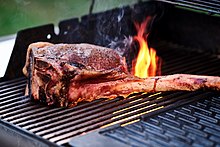
Back Anbraten German Marcado Spanish Rissoler French צריבה (בישול) HE Pelayuran ID Alum JV 시어링 Korean Melayur Malay Aanbraden Dutch Обсмажування Ukrainian


| Part of a series on |
| Steak |
|---|
Searing or pan searing is a technique used in grilling, baking, braising, roasting, sautéing, and the like, in which the surface of the food (usually meat such as beef, poultry, pork, or seafood) is cooked at high temperature until a browned crust forms. Similar techniques, such as browning and blackening, are typically used to sear all sides of a particular piece of meat, fish, poultry, etc. before finishing it in the oven. To obtain the desired brown or black crust, the meat surface must exceed 150 °C (300 °F)[1], so searing requires the meat surface be free of water, which boils at around 100 °C (212 °F).
Although often said to "lock in the moisture" or "seal in the juices", in fact, searing results in a greater loss of moisture than cooking to the same internal temperature without searing.[2] Nonetheless, it remains an essential technique in cooking meat for several reasons:[citation needed]
- The browning creates desirable flavors through the Maillard reaction.
- The appearance of the food is usually improved with a well-browned crust.
- The contrast in taste and texture between the crust and the interior makes the food more interesting.
Searing does not cause caramelization, which affects only sugars, or simple carbohydrates; the Maillard reaction involves reactions between amino acids and some sugars.[3]
Typically in grilling, the food will be seared over very high heat and then moved to a lower-temperature area of the grill to finish cooking. In braising, the seared surface flavors and colors the cooking liquid.[citation needed]
- ^ https://www.thespruceeats.com/what-is-the-maillard-reaction-995776
- ^ McGee, Harold (2004). On Food and Cooking (Revised ed.). Scribner. ISBN 0-684-80001-2. Page 161, "The Searing Question".
- ^ "The Maillard Reaction Turns 100". cen.acs.org. Retrieved 2023-06-23.